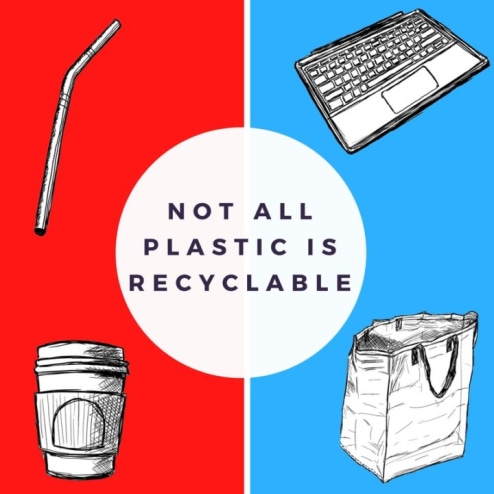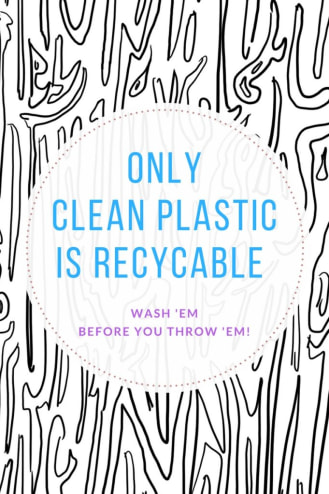For many, environmentalism begins with the recycling symbol and ends at the recycling bin. The simple act of throwing something away into a large box marked with a recycling sign is enough to make some of us feel like we've done our part.
It's like eating only half of a chocolate chip cookie-- we indulge, but not that much. Similarly, our faith in the magic of the recycling bin makes purchasing and using plastic products a little more guilt-free.
But recycling is a lot more complicated, and the process of recycling plastics is significantly less transparent than the much-Googled recipe for baking cookies.
It's a system dictated by market demand, price determinations, local regulations, the success of which is contingent upon everyone, from the product-designer, to the trash-thrower, to the waste collector, to the recycling factory worker.
We consumers play a much more critical role than we might imagine-- depending on how we use our products and in what shape we throw them away, determines their value and quality post-use. Think about it. Recycled goods have to compete with new products in the market; who wants to buy something of lower quality?
I've spent the last five months talking to various experts in Taiwan, one of the world's innovators in recycling systems AND major producers of plastics, to put together this list. My hope is to bring more transparency to a system inseparable from our very existence, but whose visibility often starts and stops at the trash can.
1. NOT ALL PLASTIC IS RECYCLABLE.

Plastic bags-- Not recyclable.
Straws-- Not recyclable.
Coffee Cups-- you need a special machine; without it, no.
Keyboards-- maybe, if you get it to the right person.
"Recycling" is determined by two really important things: the market and city government. Tweet this If there's a demand in the market, then recyclers and companies will pay for your post-consumer recyclables.
But without a market demand, those recyclables are almost useless; placing them in the recycling bin won't make a difference if you can't make money off of them. If the demand isn't there, or the quality of the materials post-use is incurably dirty, they end up in landfill or incinerators.
Your local government also plays an essential role. Government regulations create market opportunities for companies to recycle legally-mandated products. But every municipality is different. Before you throw something away, check what your city actually recycles.
Public investment in recycling systems, moreover, is integral to their long-term sustainability and success. While the price of purchasing a new piece of plastic is far cheaper than paying someone's salary to manage and sort recyclables, the environmental cost is substantially greater. Subsidies, investments and public support go a long way.
2. NOT ALL PLASTIC IS CREATED EQUAL.

Plastics are classified into 7 categories according to Resin Identification Codes (RIC). They are differentiated by the temperature at which the material has been heated, and their numerical classification (#1 - #7) only informs you what type of plastic it is. For example:
- #1 (PET), ex: water bottles -- highest recycling value; keep out of the sun to prevent toxins leaking into the container (no bueno for your health).
- #7 (OTHER) is the catch-all category. It includes non-recyclables and corn-based plastics (PLA). (As a consumer, you can't tell the difference.)
What it doesn't tell you:
1. HEALTH EFFECTS: plastic has been linked to disrupting hormonal growth and carcinogens. While its use is also associated with public hygiene and preventing bacteria contamination (many Taiwanese, for example, use plastic straws to drink everything from beer to milk out of fear of a contaminated supply chain), consumers should be wary of chemicals leaching into food or drink products.
According to the Science History Institute, "[c]urrent health concerns focus on additives (such as bisphenol A [BPA] and a class of chemicals called phthalates) that go into plastics during the manufacturing process, making them more flexible, durable, and transparent."
Most experts agree that you should stay away from #3 PVC (often found in pipes) and #6 PS (Styrofoam, often used as food/drink containers).
2. HOW IT'S MADE: Did you know that most plastics originate from crude oil? Only plastics labeled PLA are made from the sugars in corn or other plant-starches like cassava.
3. RECYCLABILITY: Oftentimes we just throw things away into the recycling bin with the full faith that theywill be recycled just because the label says its recyclable. But that's not always the case.
Moreover, there are 2 types of plastics: thermoset vs. thermoplastics. Thermoplastics are plastics that can be re-melted and re-molded into new products, and therefore, recycled. However, thermoset plastics "contain polymers that cross-link to form an irreversible chemical bond," meaning that no matter how much heat you apply, they cannot be remelted into new material and hence, non-recyclable.
3. COFFEE CUPS CAN'T ACTUALLY BE RECYCLED.

Feel good once you finish your Starbucks and place that innocuous paper cup in the recycling bin? Well, it's a little more complicated than that.
While the outside of the cup is made of paper, inside is a thin layer of plastic. The PP (Polypropylene) film protects the liquid from seeping into the paper (and thereby burning you) and keeps your warm drink from cooling too quickly.
Because there are two different materials, the cups cannot be recycled unless the materials are separated, which is impossible to do by hand and requires a special machine.
That's why the easiest items to recycle are the products made from a single material. Water bottles (100% PET plastic) are a prime example of this.
Coffee cups are similar to the packaging enclosing snacks like health bars. Both are multi-layered, with each layer serving a particular purpose, e.g. wax layer for the label, or the aluminum layer to prevent external heat from altering the chemical composition of the item before you purchase it.
This kind of design, however, makes recycling the product super difficult, especially since the layers are often very thin and stacked tightly on top of one another. It's just not cost-effective and far too time-consuming for a recycling factory to separate and recycle each piece.
4. YOU CAN'T RECYCLE DIRTY PLASTIC.

Got a little pizza sauce and cheesy goodness left on that pizza box? Now it can't be recycled (you can still compost it though!).
Any plastic material with food residues on (or in) it CANNOT be recycled. In order for plastics to be transformed into recycled goods, they must be of decent quality. So what to do?
Remember, recycled materials (i.e. your trash) must compete with virgin materials in the market, so quality matters.
In Taiwan, there are several groups of people who sort trash, remove food remnants from bento boxes, and then send the containers to the recycling factories (since the outside material is generally paper).
Some recycling factories then take these goods and wash them multiple times before they are cut, reheated and transformed.
But most of the time, a "dirty" recyclable thrown into a public trash/recycling bin doesn't even have the chance to end up at the recycling factory; it's determined useless (meaning either too troublesome, to clean, or not capable of generating income from) and lumped with all the other trash that ends up in landfill or the incinerator.
5. RECYCLING PLASTIC DOWNGRADES ITS QUALITY.

First, it's important to know that plastics are simply polymers, long chains of atoms "arranged in repeating units often much longer than those found in nature."
According to the Science History Institute, the "length of these chains, and the patterns in which they are arranged, are what make polymers strong, lightweight, and flexible. In other words, it’s what makes them so plastic."
The same piece of plastic can only be recycled about 2-3 times before its quality decreases to the point where it can no longer be used.
Additionally, each time plastic is recycled, additional virgin material is added to help "upgrade" its quality, so that the recycled product has a fighting chance in the market against new, durable and fresh goods. So when you read the label "recycled material," think twice about what the word "recycled" actually means in that context.
6. GLASS AND METAL CAN BE RECYCLED INFINITELY.

You read that right. Unlike plastic, glass and metal (including aluminum) can be recycled infinitely without losing quality or purity in the product. Tweet this There's no need to add additional virgin material in the recycling process-- recycling glass and metal is the ultimate form of circular economy, the process of using and then reusing materials without generating any waste. (Spring Pool Glass Co. Ltd., a glass recycling and innovation company based in Taiwan, is an excellent example of this.)
So then why did we make the switch to plastic? Dasdy Lin, Sustainability Consultant at the Plastics Industry Development Center (PIDC), shared these three reasons:
Global transportation shipping costs
Safety – consistency and stability of products without risk of breaking
Profit
"Say for example, I ship 100 bottles and in the end, I only receive 98 because 2 broke. That’s capital loss. But plastic rarely breaks. Plus, if we are looking at life-cycle assessment, it will probably take more energy to ship the glass bottles than the plastic ones because glass is heavier. The weight difference will result in the consumption of more fuel during transportation. So the negative effect on the environment is more fuel-burning, which results in more pollution."
7. "THE EVERYTHING ELSE" CATEGORY.

The next time you use a plastic product, flip it over and check the bottom. If you see #7 in the center of a three-arrowed triangle, you have no way of knowing for certain whether its recyclable or non-recyclable (even plastics industry people and recyclers can't tell sometimes).
#7 is the "other" put-everything-else-that-is-not-#1-6 category. It includes both non-recyclable and "biodegradable" plastics. Tweet this Polylactic acid (PLA), for example, is a #7 plastic. It is made from plant-starch instead of petroleum, and therefore, marketed as "biodegradable." (For your reference, most synthetic plastics come from crude oil.)
I use quotations here because it's important to know that current biodegradable products can only decompose if they are sent to a special factory, where the temperature and humidity is specially controlled, and lumped together with other compostable plastics. (If those plastics are thrown into landfill and mixed in with other trash, it doesn't matter if they're compostable or not. They're not going back into nature if they're stuck in between layers of other waste.)
Another example of a #7 plastic is melamine, a non-recyclable plastic used often in food containers like bowls. Its claim to fame: its durability and being dish-washer safe. In Taiwan, melamine can be spotted in night markets (beware pink bowls the next time you want to try some pork over rice 滷肉飯 (lu rou fan)). According to Dasdy Lin, you can't recycle melamine because it is a thermoset plastic: "it won’t melt again- the only way is to incinerate it."
We live in a plastic era.
From the clothes we wear to the food we eat, plastic has become a household staple for families and communities around the world. Given its prominence, and the fact that scientists estimate it takes somewhere between 450 -1,000 years to decompose (some argue it will never decompose), it is essential for us to understand this material.
*Special thanks to Cory Howell for all the incredible sketches used in the infographics!
** Thank you also to Nate Maynard, Consultant at the Chung-hua Institution for Economic Research (CIER), for cross-checking the information above and providing some of the linked academic resources!